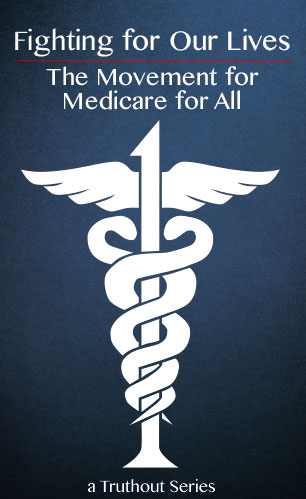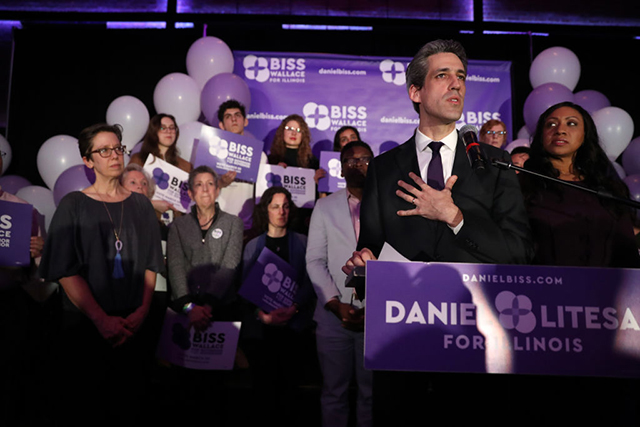
Illinois state senator Daniel Biss recently ran for governor on a platform that included support for single-payer. Biss lost, however, in the primary last month against billionaire J.B. Pritzker, who outspent his opponents by tens of millions in a campaign costing a “jaw dropping $63 million,” according to The Hill.
For single-payer advocates, the electoral defeat was disappointing, despite a respectable second-place finish for Biss. The good news, however, as Michael Lighty, public policy director of the California Nurses Association told Truthout, is that “we are seeing [gubernatorial] candidates running for offices across the country running on single-payer, many of them are viable.”
Indeed, supporters of the policy are running in California, New York, Michigan, Massachusetts, Iowa, Ohio, Minnesota, Florida, Maryland, Vermont and Colorado. “This is unprecedented,” Lighty said of the development.
If they succeed, the single-payer movement will finally have allies in governors’ mansions, shifting the terrain of political possibility, according to advocates and candidates with whom Truthout spoke.
Minnesota Governor Mark Dayton is the only governor who has publicly embraced single-payer. To put this in perspective, 122 of 192 (about 63 percent) House Democrats co-sponsor single-payer legislation, as do 17 of 49 (35 percent) members of the Democratic caucus in the Senate. That is a total of 57 percent of Democrats in Congress, compared with only 6 percent of governors.
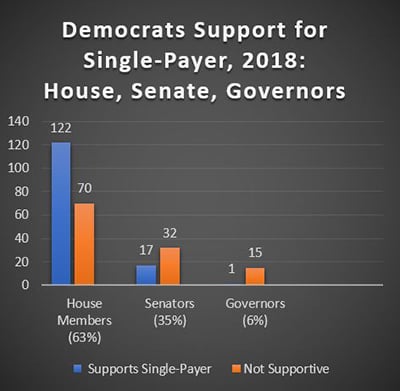 Democratic Party governors show little support for single-payer compared to Democrats in Congress. (Image: Michael Corcoran / Truthout)“We have not seen enough leadership on this issue among Democratic governors and candidates,’ said Abdul El-Sayed, a candidate for governor in Michigan, in an interview with Truthout. “It’s a defining issue in most people’s lives — so it’s a defining issue in our politics.”
Democratic Party governors show little support for single-payer compared to Democrats in Congress. (Image: Michael Corcoran / Truthout)“We have not seen enough leadership on this issue among Democratic governors and candidates,’ said Abdul El-Sayed, a candidate for governor in Michigan, in an interview with Truthout. “It’s a defining issue in most people’s lives — so it’s a defining issue in our politics.”
Beating the Establishment
Single-payer candidates will face considerable challenges from a party that has been resistant and even hostile toward the creation of a public health care system for all. This will set up yet another battle between the grassroots and establishment wings of the Democratic Party.
The candidates come from what some call the party’s “Bernie Sanders wing.” Some candidates, including Dennis Kucinich (Ohio), Ben Jealous (Maryland), Andrew Gillum (Florida) and Cathy Glasson (Iowa), have already been endorsed by the Sanders-founded Our Revolution, while other candidates have been endorsed by local branches of the organization.
Many of these candidates refuse corporate money, citing its corrupting influence on government and elections. This enables them to speak freely on issues without worrying about corporate donors turning off the spigot.
“More Democrats than we’d like to admit are bought and sold by the same health insurance lobby that has a vested interest in their bottom line, not people’s health,” said El-Sayed. “Establishment Democrats insist on running to a political center that doesn’t exist anymore.”
Indeed, many Democrats are recipients of large donations from the for-profit health industry, which is also an extremely aggressive lobby. The pharmaceutical industry spent nearly $280,000,000 on lobbying in 2017, according to the Center for Responsive Politics, nearly breaking the record set in 2009.
El-Sayed is running against Gretchen Whitmer, an opponent of single-payer. Whitmer has been the recipient of recent fundraising efforts of Blue Cross Blue Shield of Michigan, where her father was CEO for decades. As Truthout reported last month, Blue Cross pressured its employees to vote for Whitmer, showing what progressives are up against when facing Democrats supported by powerful industries.
Can progressives overcome these disadvantages?
“While the grassroots often do not have the money establishment candidates and donors do, Bernie Sanders’ campaign for president in 2016 should have taught us all the power of the message and the power of large numbers of people to truly change the narrative,” said Donna Smith, executive director of Progressive Democrats of America (PDA), in an interview with Truthout.
High Stakes, Big States
The most important governors’ elections for the single-payer movement are probably in California and New York. Both states, as Truthout has documented, have had some success pushing state-wide single-payer legislation. They have fallen short so far, but should they break through and get a bill through either state house, they will need a governor who will sign it.
“Candidates for governor who do not publicly state their support for single-payer would be a risky choice for any state hoping to advance [state-wide single-payer] measures,” Smith said.
In California, SB 562, The Healthy California Act, passed the state senate in June. The bill would create a state-wide single-payer system in California. A study from the Political Economy Research Institute that was released in May found that the bill would increase “overall system costs by about 10 percent” but “produce savings of about 18 percent.”
California Assembly Leader Anthony Rendon shelved the bill, however, drawing sharp critiques from advocates who pointed out he was the beneficiary of donations from the for-profit industry.
Governor Jerry Brown, who formerly was an advocate of single-payer, disappointed supporters when he flipped on the issue. Brown is termed out, and now Lieutenant Governor Gavin Newsom — who supports SB 562 — is the front-runner to be the next governor of California. “There’s now a big gap between (Newsom) and everyone else,” said Mark Baldassare, who is president and CEO of the Public Policy Institute, which did the March 21 poll.
“The next governor will more than likely implement single-payer in California,” Lighty said.
In New York, prospects are high for a state-wide universal health care. Assemblymen Richard Gottfried’s legislation, the New York Health Act, or A05062, has passed the Assembly with ease. They have been unable to get it past the more conservative State Senate.
New York Gov. Andrew Cuomo, however, is not seen as much of an ally to single-payer advocates. He has been mostly silent on the issue, only occasionally paying lip service to the concept of the idea in the most abstract sense, calling it a “good idea,” in September of 2017. Cuomo has not tried to advance the bill in New York, and his campaign literature does not mention anything about the subject.
However, his opponent, actress Cynthia Nixon, is unabashed in her support for the bill, and early reports (albeit anecdotal) say she is striking a chord with many Bernie Sanders supporters. Her first ad emphasized the problem of extreme wealth inequality and the need to “turn the system upside down.”
Single-Payer Impact on Races Across the Country
Other states are not nearly as close to passing the reform but are making some progress. In Massachusetts, for example, single-payer legislation was introduced in June. In addition, legislators introduced another bill, “An Act to Ensure Effective Health Care Cost Control” (S.610 and H.596), which would require the state’s nonpartisan Health Policy Commission to measure the impact that single-payer would have on costs and delivery of care in Massachusetts. If the commission finds savings from single-payer, according to the text of the bill, “it must submit a ‘Single Payer Health Care Implementation Plan’ to the legislature for consideration.”
Currently the three candidates running in the Democratic primary “all said they support moving the state to a single-payer system,” according to MassLive.
This is the second Massachusetts gubernatorial election in a row where at least one Democrat has raised the issue. In 2012, former head of the Centers for Medicare and Medicaid Services under President Obama, Donald Berwick, finished a strong second place, with single-payer as his central issue.
In Vermont, a liberal state with a Republican incumbent, single-payer is admittedly a dicey issue after the last efforts blew up in 2014. Still, as the state pivots toward universal primary care, there is still support for single-payer among the candidates.
“We currently have three candidates running in the Democratic primary — James Ehlers, Christine Hallquist and Ethan Sonneborn. All three aspire to a single-payer/Medicare for All system, though they likely have different timelines on how to get there,” Conor Casey, executive director of the Vermont Democratic Party, told Truthout.
It is not a secret in Vermont that the political capital to realistically obtain single-payer does not currently exist. Still, they are making the case, as James Ehlers told Truthout, because governors have the ability to help build support for policies and expand the debate.
“One of the most powerful aspects of the office, regionally and nationally, is the ability to use that leadership to build coalitions,” Ehlers said.
Meanwhile, Colorado is unlikely to implement single-payer soon. Supporters are still dealing with the fallout from having lost a ballot initiative for single-payer by 60 points in the 2016 election. Even in 2016 many powerful Democrats in Colorado were unsupportive of the plan. The current governor, Democrat John Hickenlooper, who opposed the referendum, is termed out. Democrat Jared Polis is running in the coming election and has supported single-payer as a co-sponsor to HR 676. Polis ran ads on the issue in 2008 — a fact he proudly notes on his campaign website. He has been described by The New York Times as the “probable front-runner” in a crowded field.
In Minnesota, single-payer has become a top issue in the gubernatorial race. The local branch of Our Revolution endorsed three candidates (one has since dropped out) including Rebecca Otto and Erin Murphy, both of whom support the reform. Otto has introduced her own plan for state-wide single-payer. They are running against Rep. Tim Walz, who is not a co-sponsor of HR 676. He does say on his campaign site that (emphasis added) “he believes that a single payer type system is on Minnesota’s horizon, but that immediate action needs to be taken to control costs and improve care.” He then advocates for a “public option” instead.
Prospects for Victory
It can be hard at this stage to get a full accounting of the prospects for some of these candidates. But there are some polls as well as anecdotal evidence suggesting that many of these candidates should not be taken lightly by opponents.
Ben Jealous, former head of the NAACP and a very visible Bernie Sanders surrogate during the 2016 primary is running in a “wide open” field in the Democratic Primary, as The Washington Post reported in February. According to a February 22 Goucher Poll, Jealous had 10 percent support, coming in third place in a field with nine candidates — two points behind Kevin Kamenetz (12 percent) and Rushern Baker (19 percent).
Mother Jones described the Jealous campaign as “one of the seven Democratic primaries in 2018 that would shape the future of the party.” Jealous also scored an endorsement from California Senator and possible presidential hopeful in 2020, Kamala Harris. (She has also endorsed Newsom in her own state, though has not publicly supported SB 562.)
Another exciting race is in Iowa, where “progressive crusader” Cathy Glasson is running a campaign with a strong emphasis on single-payer.
Glasson has implored the Iowa State Legislature to look into the Healthy Iowa Program (House File 2352), which would create “a true publicly-administered single-payer health care system that covers every Iowan.”
“Throughout this campaign, I’ve said we need to move forward with a universal, single-payer health care system right here in Iowa,” Glasson said in a statement in February.
Single-Payer Candidates Lacking in Some States
Gov. Kate Brown of Oregon is a popular progressive but has fallen short of unqualified support for single-payer. As of March 28 her website’s health care page does not mention the words “single-payer,” “Medicare for All,” or “universal.” She only says, “Every Oregonian deserves to have a doctor they can count on and healthcare they can afford.”
Brown recently praised the Center for American Progress’s market-based plan for health reform, “Medicaid Extra for All,” on Twitter, prompting followers to plead with her to support Medicare for All. Many single-payer advocates see the Center for American Progress’s plan as an insufficient measure that leaves the for-profit system intact:
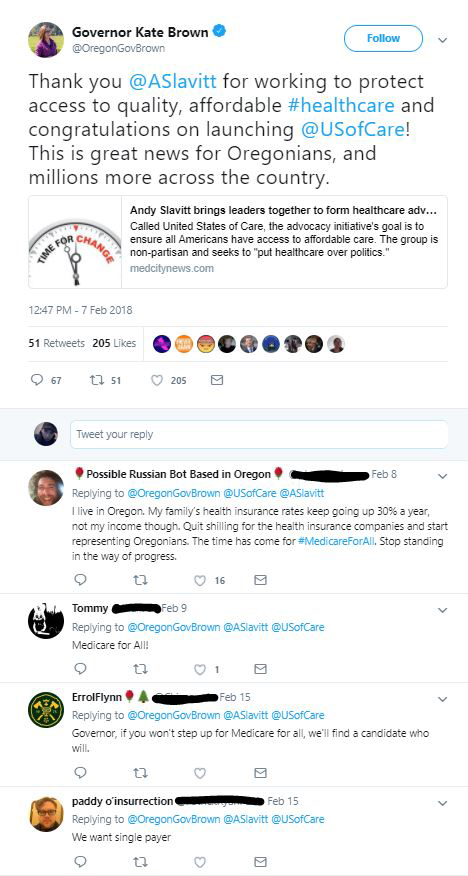 When Kate Brown praised the Center for American Progress health plan, she got flak on social media from advocates of single-payer and “Medicare for All.” (Image: Gov Brown’s Twitter Account)Brown does, however, have supporters who favor single-payer. “Universal health care advocates are focusing on their long game,” said Lee Mercer of Health Care for All, Oregon.
When Kate Brown praised the Center for American Progress health plan, she got flak on social media from advocates of single-payer and “Medicare for All.” (Image: Gov Brown’s Twitter Account)Brown does, however, have supporters who favor single-payer. “Universal health care advocates are focusing on their long game,” said Lee Mercer of Health Care for All, Oregon.
Brown was asked “whether she supports a universal health care or a single-payer system of health care,” in an interview with the Oregon-based Eugene Weekly published on January 25.
“I certainly support everyone having access to health care, so I would say ‘yes’ to universal,” Brown said, emphasizing her work to help insure 95 percent of the state. “I’d like to continue to sustain this program until I see something better.”
The Brown campaign did not respond to a request to clarify her position.
In Connecticut the only pro-single-payer candidate, local advocates tell Truthout, was Middletown Mayor Dan Drew. He has dropped out of the race, however, citing a lack of funds.
The remaining candidates, including former progressive icon Ned Lamont, have said little to nothing on the issue. Susan Bysiewicz, former Secretary of State in Connecticut, did say in a forum debate that (emphasis added) “we could make a tremendous economic difference for our state if we move in the direction of single payer,” but only went so far as to support lowering the age for people to qualify for Medicare.
Centering Health Reform on Election Day
Democrats have been making a lot of mistakes in recent years: They have allowed Republicans to win 33 governorships, one short of a historic high set about 100 years ago. Many progressives cite the Democratic Party’s tepidness on core issues like single-payer, and the reasons behind that weakness: The party’s relationship with donors from the for-profit health industry clearly influences its positions. Lighty also notes that “labor and consumer groups are so craven to the Democratic Leadership” that they will often endorse establishment candidates who are weaker on the issues that matter most to the working class.
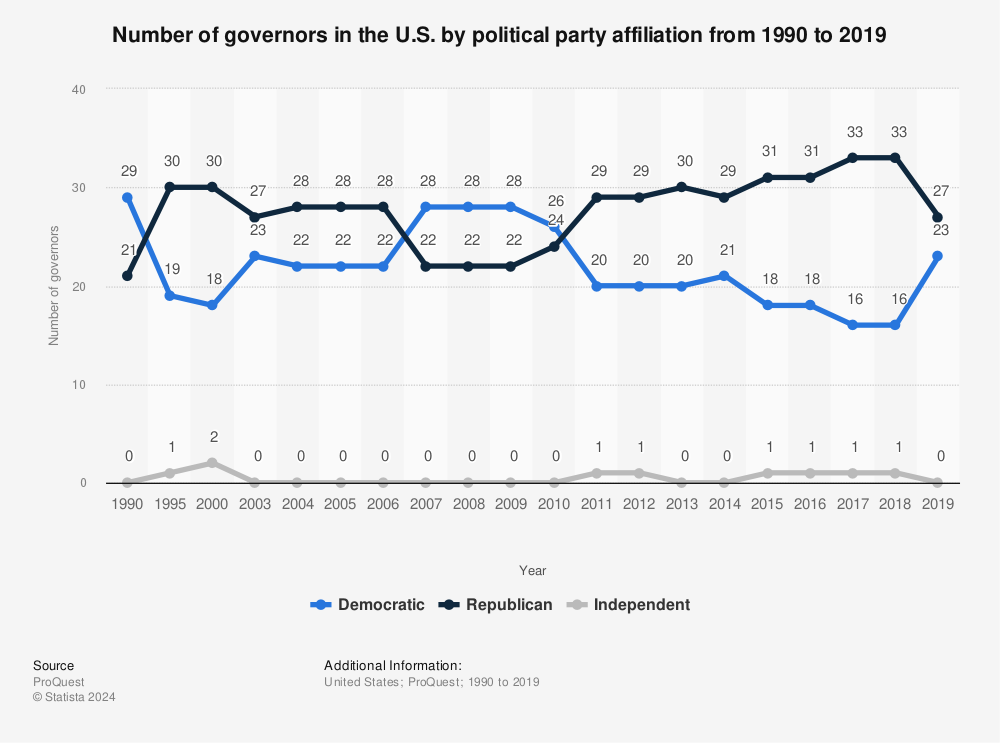
Find more statistics at Statista
Recent polls show that health care is the top concern for American families, and most Americans, particularly Democrats, support Medicare for All. Candidates are hoping that single-payer can be a winning message.
Democrats are “bullish on governors’ races,” according to Bloomberg, with 36 gubernatorial seats up for grabs this year, 26 of which are held by Republicans. This is good math for the party, but Democrats were optimistic in 2016 as well, and lost ground again, dropping two more governorships and the White House.
Still, the explosion of single-payer candidates is a sign of progress. Win or lose, these gubernatorial races are certain to spark conversations across the country about why health care should be not a commodity but a right.
Our most important fundraising appeal of the year
December is the most critical time of year for Truthout, because our nonprofit news is funded almost entirely by individual donations from readers like you. So before you navigate away, we ask that you take just a second to support Truthout with a tax-deductible donation.
This year is a little different. We are up against a far-reaching, wide-scale attack on press freedom coming from the Trump administration. 2025 was a year of frightening censorship, news industry corporate consolidation, and worsening financial conditions for progressive nonprofits across the board.
We can only resist Trump’s agenda by cultivating a strong base of support. The right-wing mediasphere is funded comfortably by billionaire owners and venture capitalist philanthropists. At Truthout, we have you.
We’ve set an ambitious target for our year-end campaign — a goal of $250,000 to keep up our fight against authoritarianism in 2026. Please take a meaningful action in this fight: make a one-time or monthly donation to Truthout before December 31. If you have the means, please dig deep.
